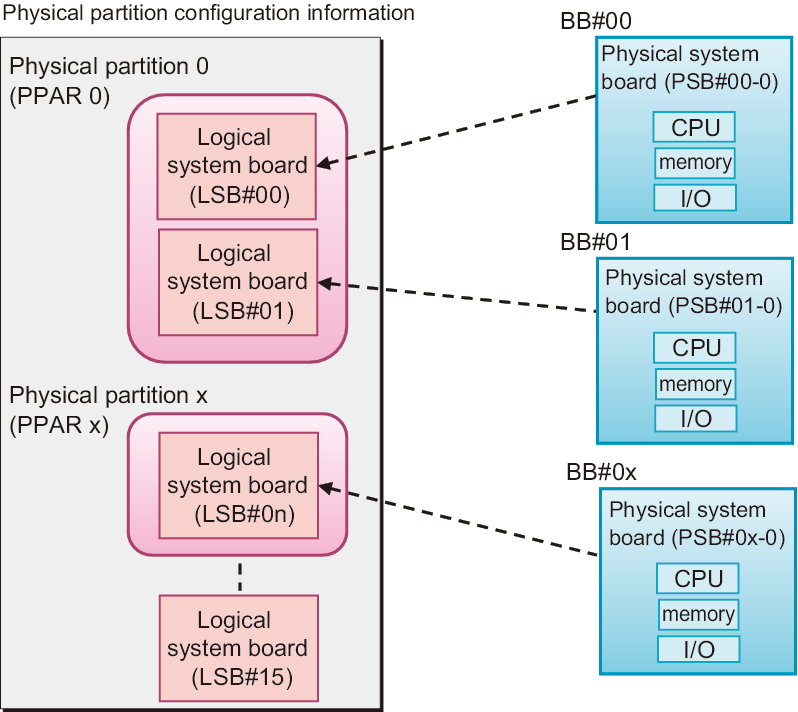1.3.1 Understanding Physical Partition Components
1.3.1 Understanding Physical Partition Components
A physical partition consists of multiple building blocks. In a configuration that is not a building block configuration, one server is one physical partition. The XSCF firmware handles one building block as one physical system board (PSB) when configuring a physical partition. A physical system board consists of three types of resources: CPU, memory, and I/O device. In the physical partition, the hardware resources of the physical system boards are assigned to logical system boards (LSB).
- Physical system board (PSB)
The PSB consists of physical components (CPU, memory, and I/O) mounted in one SPARC M12/M10 chassis. In the SPARC M12-1/M10-1, a physical system board is a motherboard unit. In the SPARC M12-2/M12-2S/M10-4/M10-4S, a physical system board is a CPU memory unit (including lower (CMUL) and higher (CMUU)). A physical system board may be used as the unit representing a chassis, in maintenance for adding/removing/replacing a SPARC M12/M10 chassis. For a system with a building block configuration, a physical system board refers to a building block (BB). - Logical system board (LSB)
The LSB is a logical unit name assigned to a physical system board. Each physical partition has a set of logical system boards assigned to it. With one PSB number assigned to the logical system boards in the physical partition, they can be recognized in the system.
LSB numbers are used to control the assignment of resources such as memory to the physical partition. - Physical partition number (PPAR-ID)
The PPAR-ID is a number that identifies a physical partition. You can assign a number ranging from 0 to 15. However, the following restrictions apply to physical partition numbers:- For SPARC M12-1/M12-2/M10-1/M10-4The physical partition number is fixed to 0. You cannot change the value.- For SPARC M12-2S/M10-4SYou can assign a physical partition number that is the same as the BB-ID of a chassis mounted on the system. If the BB-ID of an unmounted chassis is specified as a physical partition number, the power-on of the physical partition will fail. For details on the physical partition configuration recommended in consideration of SPARC M12-2S/M10-4S removal, see " 4.2 Configuring and Operating a Physical Partition."[Example] For a system with BB#0 and BB#1 mounted, 0 or 1 can be assigned as a physical partition number. If you specify 2 as a physical partition number, the power-on of the physical partition will fail.
The mapping between the logical and physical system boards on the physical partition is set in the physical partition configuration information (PPAR configuration information). Figure 1-17 is a conceptual diagram of this mapping.
|
Figure 1-17 Conceptual Diagram of Mapping Between Logical System Boards and Physical System Boards
|

|
All the system boards that are targets for dynamic reconfiguration must be registered in the physical partition configuration information (PPAR configuration information) for the relevant physical partition. Use the setpcl command for their registration in the PPAR configuration information.
PPAR configuration information maps logical system boards (LSB) that comprise the physical partition to physical system boards (PSB) which are hardware resource information, and is managed with XSCF. Each piece of PPAR configuration information also stores setting information on the hardware resources of the PSBs mapped to the physical partitions and LSBs.
< Previous Page | Next Page >